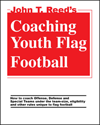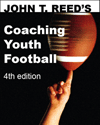What is the main key to youth football offense?
by John T. Reed
Copyright 1999, 2000 John T. Reed

 Detailed versions of my approach are in my books, Coaching Youth Football and Coaching Youth Flag Football.
Detailed versions of my approach are in my books, Coaching Youth Football and Coaching Youth Flag Football.
95% of the time, when a youth offensive play fails, it is because one or more players did not know their assignment. Coaches think plays fail because their guy got beat. Film study reveals that almost never happens.
Let’s say you run an off-tackle play and it is stopped for no gain by an inside linebacker. The typical youth coach will conclude that his blocker tried to block the inside linebacker, but was not up to the task. In fact, study of the film will reveal that the guy who was supposed to block the linebacker never made the slightest effort to do so. Either he hopped around doing what I call “looking concerned,” or he blocked someone else.
In many cases, the reason the player does not know whom to block is that his coach never told him. And the reason for that is generally that the coach never thought about it. If I came to one of your practices and put your offensive coordinator and offensive line coach into the line as players, then set up various defenses like the 5-3, 6-2, 4-4 and asked who blocks each defender on a particular play, I suspect there would be some hesitance, confusion, and disagreement among the adult coaches.
If the coaches do not know, instantly, exactly whom each player blocks against each possible defense for each play in your play book, how can anyone expect the players to know?
The fix for this problem is the fit-and-freeze drill. First diagram the blocking for each of your plays against each of the defenses of your upcoming opponent. You know their defenses from scouting. If you do not scout, may God have mercy on your doomed offensive coordinator soul.
After you have diagramed the plays against those defenses, line up your defensive scout team in one of those defensive alignments and show each player whom he blocks and how. Then test their knowledge by calling out a play name and saying “Go.” On “Go,” each player walks to the guys he's supposed to block, puts his shoulder against him, and freezes. Defense offers no resistance and stays where they started unless told to move. Typically, you would have contain men or defenders who are going to be trapped move across the line of scrimmage.
After the players freeze, coaches walk along and check to make sure each is blocking the right guy and has his helmet on the correct side. In the case of double-team blocks, check for a good seal between the hips and shoulders of the blockers. You must do the fit-and-freeze drill for each of your plays against each defense of the upcoming opponent and with each string of your offense.
This takes forever!
If you did not already know, you will quickly learn that it is impossible to have more than four to 20 plays, depending upon the age you are coaching. Do the fit-and-freeze drill first thing every day for each play you have put in. Do not put in a second play until all offensive players have mastered the first play against all defenses. Do not put in a third play until they have mastered the first two. And so on. You will find that you are spending almost all of your initial practice periods on the fit-and-freeze drill. So be it. There is no point in working on how to block until your players know exactly whom to block. A great block on the wrong defender is worthless.
After they can fit and freeze a play correctly, run it at full speed. If you have rookies who are still learning how to hit, make it a hitting-tackling scrimmage. If the play fails in scrimmage, find out whose man made the tackle and check that blocker's knowledge of his assignments.
As the season progresses, if you have not put in too many plays, you will be able to move on to the finer points of the blocks and the timing of handoffs and such. The typical youth-football coaching staff has done an extremely poor job of teaching, or even deciding, blocking assignments. They are instead wasting time on ritualistic nonsense like hitting sleds or ramming their shoulders into blocking dummies really hard.
All you have to teach in the beginning about blocking technique is the rules and which side to put your helmet on. In the case of a double-team block, teach keeping shoulders and hips touching your teammate. The combination of vast knowledge of their blocking assignments and half-vast blocking technique will work. The opposite will not. 95% of the failures are from not knowing assignments. Work on fixing that first. Then, when that's squared away, you can work on the other 5%, which stem from blocking-technique errors and mismatches.
I am assuming here that your players are not afraid to be on the field. In youth football, some timid players will literally step out of the way of defenders. That has nothing to do with knowing assignments or blocking technique skills. They are simply afraid of the opponents and do not want to be there. These kids are like the lion in the Wizard of Oz. They need courage. Until they get it, put them at flanker.
The rest of your players are like the scarecrow. They needs brains when it comes to knowing whom to block. In the climactic scene of The Wizard of Oz, the scarecrow gets his brain in the form of a diploma and demonstrates it by reciting the Pythagorean Theorem---The square of the hypotenuse of a right triangle is equal to the sum of the squares of the sides. Your players need to be able to put on a similar knowledge demonstration regarding their blocking assignments versus the 5-3,- 6-2, and 4-4 for your off-tackle play.